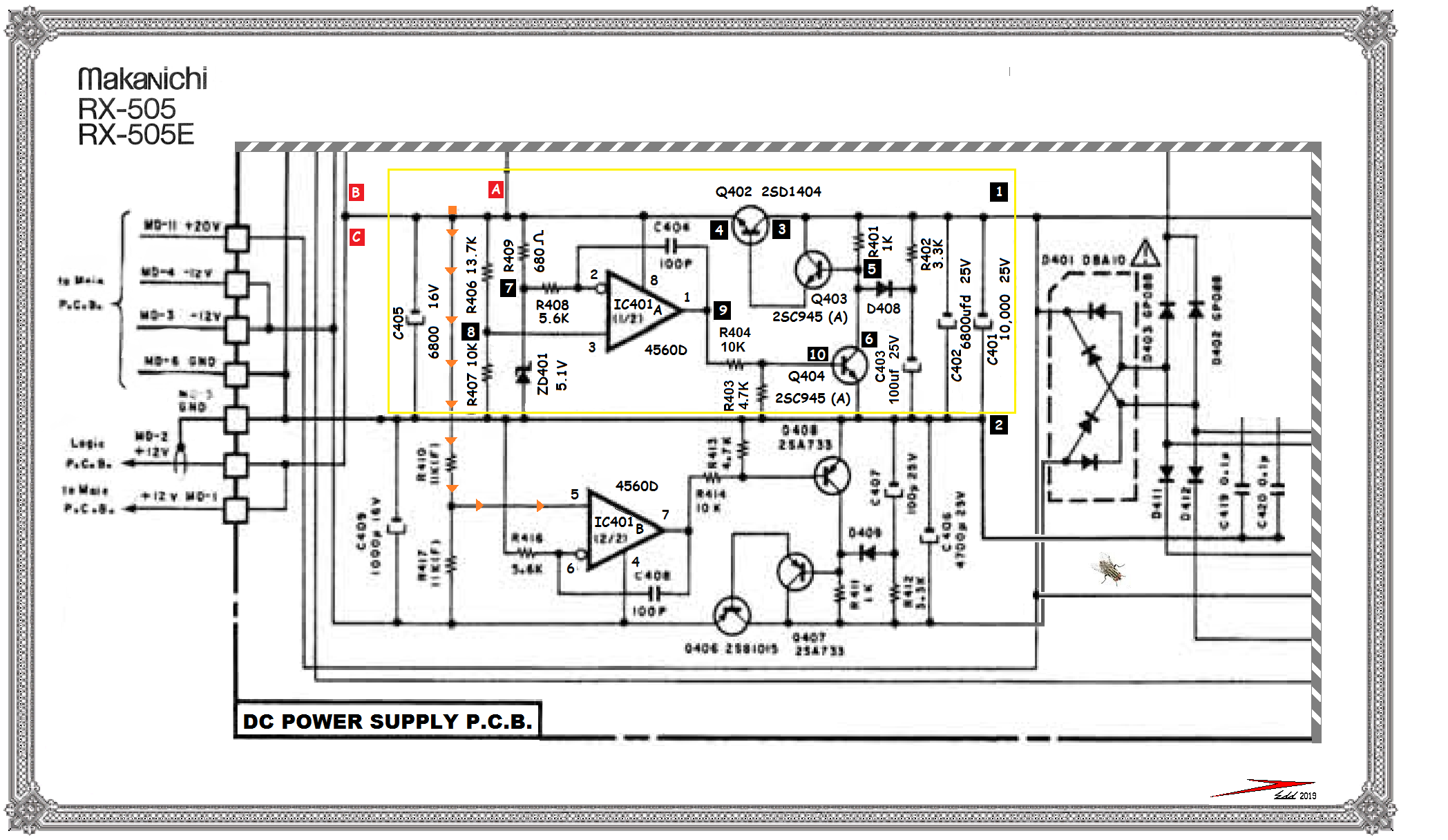Sir Kilgore Cemetery . . . . .
Where ? you go o o o o o o o o ?
(Had a backlog on enbalming jobs and not caught up yet ?)
Submitted, herewith, an evaluation of your situation . . . .
I see the initial +20volts (19.7 in your situation) is coming into
BLACK 1 and with
BLACK 2 being the common ground for both + and -supplies.
Initially that 10 . . . .
TOUSAND motherfarads of capacitance
DOES check out against the parts list . . . along with an additional 6800 shunting it.
Now thats enough capacitance for a 12V @ 15 amp supply to be outputted !
OR . . . . for a low level audio amp supply to have a background noise threshold lower limit, of a mouse peeing on a cotton ball !
Now, as far as the negative supply, all seems to be well with it, since it is being in error as an equally like amount as the positive supply counterpart is.
It is just a duplicate build of the + power section . . . built upside down, backwards and reverse polarity, with the one minor difference of the
ORANGE ARROW path supplying it a sample of the positive supply to be able to track.
Seems like if there is not a problen brought on by overloading of the positive supply, that the fault should be within the
YELLOW BOX area.
First . . . . in a no power up yet, situation . . . . . ohm out the soon to be +12V output bus at any of the
RED A-B-C references. See if there is any chance of there being a 12ohm or less reading, that woulld be loading and pulling down that 12V supply.
RED A feeds up to be switched by , Q412, located directly above IC401 A section, with very low drain to be expected by a logic circuit that it feeds.
RED B and C were not fully tracked down but
C branches out a bit lower left down on the schema.
If that clears as not being a fault we can now power up and do some dynamic evaluations.
Phase 1 . . . .
Peparation is to heat the collector lead of Q404 such that it can be tilted and permit its lead be pulled thru its pcb hole and then be floating out of circuit.
Now with your past dealings, I believe that you will be having stocked a 12V zener of 750mw / 1 / or / 2 watt rating on hand or be cannibalizable from other equipment.
If not, a 10.1 or 9.1 value will also fulfill.. We will just get a lower voltage, less the pass transistors voltage drop.
With Q404 no longer influencing the circuitry, along with that added zener we should come up with the most basic regulator circuitry, if you install the zener cathode to the
BLACK 5 junction and its anode to the
BLACK 2 common ground buss..
IF . . . and heavy on the
IF, you did not have the zener, use a 1K resistor instead, and it, plus the R401 combo will make a voltage divider and end up with
~1/2 of your 20 V supply at the emitter of Q402 pass transistor instead of the normal +12V.
If that then creates the expected voltage output , that dispells any overloading pull down of the supply, and we need to examine Q404 in depth.
Power down and reinstall Q404 collector in its hole.
Now power up and we will see if Q404 was what was influencing the low voltage situation.
If the outputted voltage was less than before, short the base of Q404 (
BLACK 10 )
or their shared common junction of R403-404 to BLACK 2 . . . . . to the common ground buss . . .
BLACK 2.
That should then have Q404 totally free and incapable of influencing the
BLACK 5 voltage and the power supplys overall output when Q404 base is grounded out.
If that is not the case , replace Q404 and we continue.
I now await for your testing . . . . ..
FLASH . . . .
I see that you just came on with your reply, just as I was finishing this.
The loading down, to pull down the supply still pertains, so confirm that.
SO . . . . with a new Q404 in circuit you can proceed directly to installing the zener or which other option you choose for it and try the shorting of the Q404
to ground and see if the Q404 is not causing a drop of the voltage . ( Not expected now, but an excess base drive level to it instead . )
If it is not, then pull out a 4.7K, 2.2K, 1K and 470 ohm resistors and move to R403 and start sequentially shunting the highest to lowest values of resistors across it.
Each lower value should result in an increasingly higher voltage output from the supply.
Considering so, how close did the lowest value resistor make the supply come up to ?
Next check the R407, R406, R409, R408 . . . . . . . and the R404-R403 resistors for accuracy to value specs. Also is the ZD401 at 5.1 ?
ENHANCED SCHEMATIC REFERENCING . . . . .
https://i.postimg.cc/7qsGpw5q/Nakamichi-Power-Supply.png
73's de Edd . . . . .
Education is what you have , if you don't have access to books, your Smart Phone or your computer.



